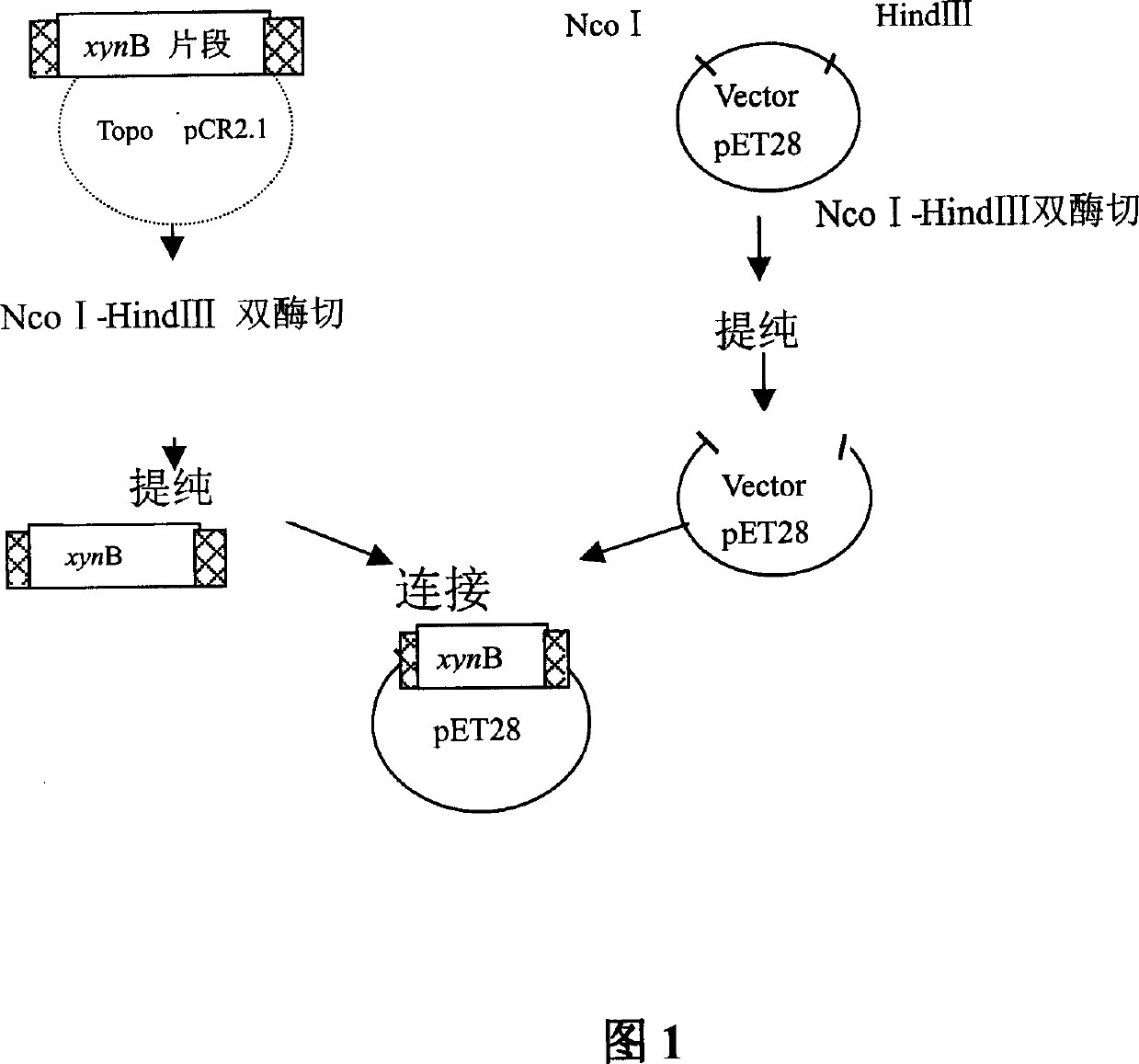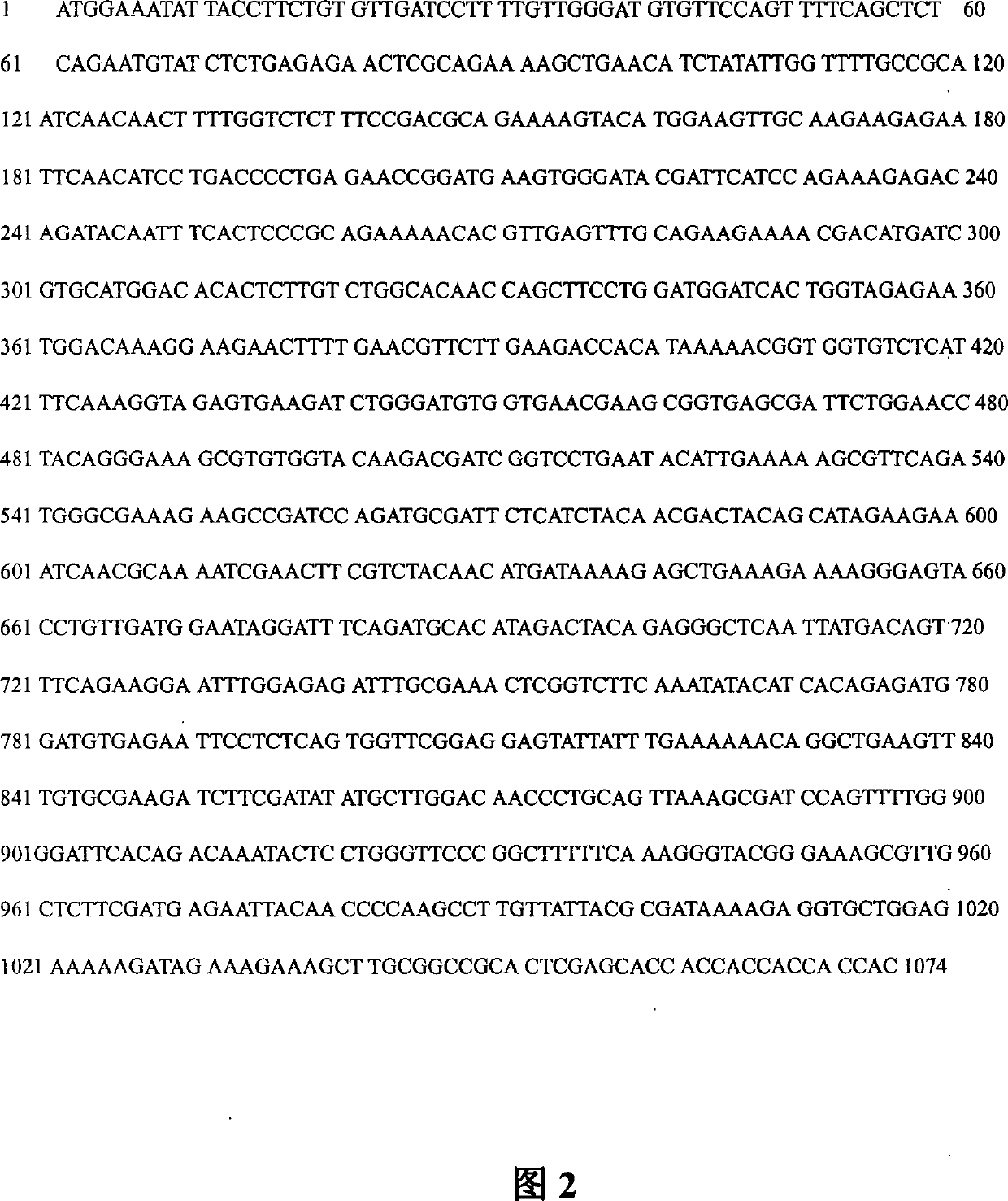Heat-resisting xylanase and gene coding the xylanase
A technology of xylanase and encoding, which is applied in the field of xylanase and can solve problems such as industrial application limitations
- Summary
- Abstract
- Description
- Claims
- Application Information
AI Technical Summary
Problems solved by technology
Method used
Image
Examples
Embodiment 1
[0025] Example 1 Extraction of Thermotoga maritima Genomic DNA
[0026] 20 g of fresh wet bacteria of Thermotoga maritima (Thermotoga maritima MSB8, German Culture Collection, DSM3109) were used to suspend in 10 mL of 50 mM Tris buffer (pH 8.0), and a small amount of lysozyme and 8 mL of 0.25 mM EDTA (pH 8. 0), mix well and place at 37°C for 20min, then add 2mL of 10% SDS, place at 55°C for 5min, extract once with equal volumes of phenol and chloroform respectively, take the last supernatant, add 2 times the volume of ethanol, DNA recovery. Wash with 70% and absolute ethanol respectively, dissolve the precipitate in 0.5mL TE buffer solution (pH8.0, 10mM Tris, 1mM EDTA), add 3μL of 10mg / mL RNase, incubate at 37°C for 1h, and extract with equal volumes of phenol and chloroform respectively. Extract once, add 2 times the volume of ethanol to the supernatant, recover DNA, wash with 70% ethanol and absolute ethanol respectively, vacuum freeze-dry, and dissolve with ultrapure water...
Embodiment 2
[0027] Example 2 Amplification of xylanase gene xynB
[0028] A pair of primers were designed, and the Nco I-Hind III restriction sites capable of being inserted into the pET28a(+) plasmid (Novagen) were introduced into the primers. The sequences of the primers TM-XynB-Nco I-FWD and TM-XynB-Hind-His-REV used are as follows:
[0029] TM-XynB-Nco I-FWD: 5′-CCATGGAAA TATTACCTTCTGTGTGAT
[0030] TM-XynB-Hind-His-REV: 5′-AAGCTTTCTTTCTTCTATCTTTTTCTCCA
[0031] When designing the TM-XynB-Nco I-FWD forward primer, it is considered that the C-terminus in the expression vector has a 6×His tag, so that the second amino acid from the Nco I restriction site is changed from K to E after translation. This mutation according to the primer design ensures that the target gene is cloned in the open reading frame, with ATG start codon and 6×His tag sequence at the same time, without open reading frame drift.
[0032] Using the genomic DNA of Thermotoga maritima as a template, polymerase was used...
Embodiment 3
[0034] Cloning and DNA sequence determination of embodiment 3PCR product
[0035] After the PCR amplification reaction, the present invention uses topological TA cloning to clone the xynB gene fragment into the pCR(R)-2.1Topo plasmid vector, and screens colonies with recombinants by colony PCR. Then, use the standard primer sequence on the pCR(R)-2.1Topo plasmid vector as a primer to measure the DNA sequence of the xynB gene, and purify the plasmid containing the xynB gene sequence for further subcloning and expression.
[0036] The present invention adopts terminal termination method (capillary electrophoresis fluorescence method) for sequencing, and the reagent used for sequencing is the Dye Terminor Cycle sequencing kit (Perkin-Elmer, USA). The composition of the sequencing reaction mixture is: Terminator Ready Reaction Mix, 4μl; Plasmid Solution, 3μl; Forward or Reverse primer, 1.5μl; H 2 O, 1.5 μl; the total volume of the reaction mixture was 10 μl. The sequencing cycle...
PUM
 Login to View More
Login to View More Abstract
Description
Claims
Application Information
 Login to View More
Login to View More - R&D
- Intellectual Property
- Life Sciences
- Materials
- Tech Scout
- Unparalleled Data Quality
- Higher Quality Content
- 60% Fewer Hallucinations
Browse by: Latest US Patents, China's latest patents, Technical Efficacy Thesaurus, Application Domain, Technology Topic, Popular Technical Reports.
© 2025 PatSnap. All rights reserved.Legal|Privacy policy|Modern Slavery Act Transparency Statement|Sitemap|About US| Contact US: help@patsnap.com



